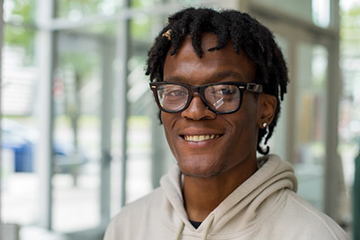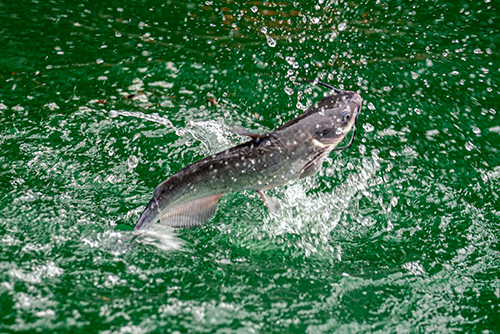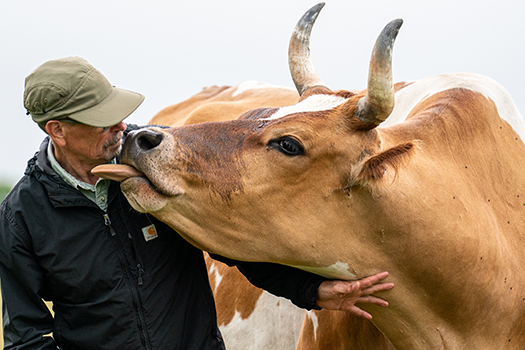By Donté Smith

Donté Smith
After spending most of my time in the Michigan State University journalism master’s program honing my photography skills, in the last year I focused on developing my writing and storytelling.
Joining the Great Lakes Now team allowed me to apply these skills in a new way while learning new techniques, like creating social media content, to stay prepared for the ever-changing world of journalism.
Experiences with Capital News Service and Great Lakes Echo gave me the confidence to pitch new story ideas and suggest fresh concepts for existing pitches.
My photography experience was appreciated, and I benefited from being around other photo- and video-focused people. They gave me new ideas for capturing images and suggested gear that would help me get the right shots for a story. While serving as both the reporter and the photographer for assignments was challenging, it helped me grow in both areas.
Joining the Great Lakes Now team was intimidating at first.
Being under the Detroit Public Television (PBS) umbrella, the organization was facing challenges related to federal funding reductions. I commend the Great Lakes Now team for providing me with engaging experiences while dealing with these challenges.
This experience taught me how much the world of journalism is constantly changing and that organizations like PBS will need to lean on their community-based models to face these challenges.

A catfish leaps out of the water while being reeled in by a fisher at Spring Valley Trout Farm in Dexter, Michigan (Photo Credit: Donté Smith/Great Lakes Now)
My first tasks as an intern included simple things like the “PFAS News Roundup,” where we compiled other reporting on PFAS contamination in the Great Lakes region into a bi-weekly report that included some original writing. This task, and others related to social media, helped me familiarize myself with Great Lakes Now’s vision and gave me time to research my own pitches.
From day one, the team knew they wanted me to work on stories that included photos and visuals. This would help me continue to develop those skills while giving them much-needed original content and variety for their website and social media.
The first story I pitched focused on farm animal sanctuaries, and I found several sanctuaries in Michigan that also pride themselves on sustainable practices. The Great Lakes Now team helped me identify researchers and studies that widened the story’s scope to the entire Great Lakes region while still allowing me to format it as a feature on one specific sanctuary.
After a few calls, I set up a half-day visit with the founders of one of these sanctuaries and created my favorite piece from my time with Great Lakes Now.
“Empowering Environmental Stewardship” allowed me to spend one-on-one time with the staff and some of the animals. More than just getting some fantastic photos, it allowed me to see the sanctuary up close, better understand its inner workings and translate that experience into a written story.
After spending so much time on the main subject, Tim McKernan, the co-founder and operations director, he began opening up about topics that I don’t think he would have in a 30-minute phone interview.
Juggling photography with reporting was a welcome challenge that prepared me for later stories, and having so much time with the subjects allowed me to dedicate time to both.

Cow resident, Hopper, greets Tom McKernan, sanctuary co-founder, while grazing the pastures at Barn Sanctuary in Chelsea, Michigan. (Photo Credit: Donté Smith/Great Lakes Now)
While working on articles for the website helped build my writing skills, a lot of my time was spent creating content for Great Lakes Now’s social media. I helped clip the monthly 30-to-45-minute episodes into smaller 2-to-3-minute segments and wrote captions for them to be scheduled to post on social media after the episodes aired.
This work wasn’t creating my own stories or content from scratch, but it made me feel like an important part of the larger promotional strategy. One of my clips even became one of Great Lakes Now’s most viewed on Instagram.
I was also tasked with creating social media posts to promote my own writing and using my photos to create graphics to drive more traffic to the articles. This gave me the opportunity to connect with some of the subjects on social media and observe the open discussions around my stories on those platforms. These social media projects broadened my skillset and showcased my writing in different ways. I am proud of the social media content I was able to create around my “Fish Farming” story.
Ultimately, my time at Great Lakes Now was a special experience.
I learned things that I hope to carry with me no matter where my career takes me. I am more confident as a writer and believe I possess a unique skill set from this experience that will make me more competitive in the job market. I am proud of every project I worked on and hope Great Lakes Now can stay true to its vision amid the changes that will continue to happen in the journalistic landscape around it.
